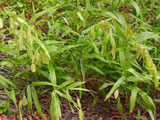Native Plants

Q. Who is Mr. Smarty Plants?
A: There are those who suspect Wildflower Center volunteers are the culpable and capable culprits. Yet, others think staff members play some, albeit small, role. You can torture us with your plant questions, but we will never reveal the Green Guru's secret identity.
Did you know you can access the Native Plant Information Network with your web-enabled smartphone?
Ask Mr. Smarty Plants is a free service provided by the staff and volunteers at the Lady Bird Johnson Wildflower Center.

rate this answer
Monday - June 18, 2012
From: Leander, TX
Region: Southwest
Topic: Xeriscapes, Drought Tolerant, Groundcovers, Shade Tolerant, Grasses or Grass-like, Herbs/Forbs
Title: Ground cover under live oaks
Answered by: Guy Thompson
QUESTION:
I have some areas under Live Oak trees (maybe 200 sq. ft.)that remain bare, in spite of trying Habiturf. Soil is dry, poor and shallow. Can you suggest a living ground cover that would not require major rework of the soil?ANSWER:
I have had the same experience as you, except my bare ground is under deciduous oaks, Quercus texana (Nuttall oak). I am experimenting with several native plants that will survive drought. I'm having pretty good luck with Calyptocarpus vialis (Straggler daisy), Carex planostachys (Cedar sedge), Salvia lyrata (Lyreleaf sage), and Paspalum setaceum (Thin paspalum). Some of the other sedges, such as Carex texensis (Texas sedge) and Carex amphibola (Creek sedge) might do well, although they might need slightly more water than Habiturf. These are all mowable at a height of about four inches. The first four species are common around suburban Central Texas, and I simply transplanted some from other spots in my yard. I also tried Tridens muticus (Slim tridens), but it seems too coarse for a lawn. If a taller grass will fit in, try Chasmanthium latifolium (Inland sea oats), which grows to about two feet in height and does very well in shade.
Images of some of my suggested species are shown below.
From the Image Gallery
More Shade Tolerant Questions
Hibiscus to grow in partial shade in North Carolina
September 25, 2009 - What variety of hibiscus can I plant in Lexington, NC? Are there any variaties that tolerate partial shade?
view the full question and answer
Shade-loving Grass for the Houston area
February 09, 2011 - I have an ash tree that completely shades the majority of our front yard and is not allowing the St. Augustine grass to grow. Is there a shade-loving grass good for the Houston area?
view the full question and answer
Balancing bloom in beds in Kents Store VA
May 26, 2010 - Our beds along a walkway in rural Central VA have replanted themselves - oenethera speciosa and dwarf yarrow have abandoned the north bed and are flourishing in the south bed. Sedums, lavender and can...
view the full question and answer
Erosion Control with perennials for a shady Dallas bank
July 25, 2013 - Thank you for your help with turf or perennials on a shaded bank, 4000 sq ft, for the Dallas area that has good roots, grows in semi shade to shade, is on a steep bank so cannot mow, and flowers the l...
view the full question and answer
Native ground covers for shade in East Texas
June 06, 2008 - I live in Mount Pleasant, Texas which is in northeast Texas. I would like a list of ground covers that would do well in our area. The place I want to put it gets a lot of shade. The ground is clay. Th...
view the full question and answer
| Support the Wildflower Center by Donating Online or Becoming a Member today. |

